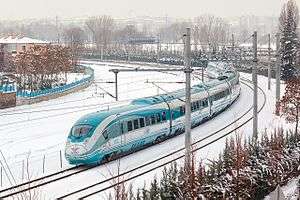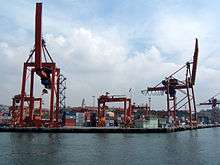Turkish State Railways
The State Railways of the Republic of Turkey (Turkish: Türkiye Cumhuriyeti Devlet Demiryolları), abbreviated as TCDD, is a government-owned national railway company responsible with the ownership and maintenance of railway infrastructure in Turkey, as well as the planning and construction of new lines. TCDD was formed on 4 June 1929 as part of the nationalisation of railways in Turkey.[2]
 | |
 Map of the TCDD railway network. TCDD owns and maintains all railway infrastructure in Turkey, while TCDD Taşımacılık operates train service. | |
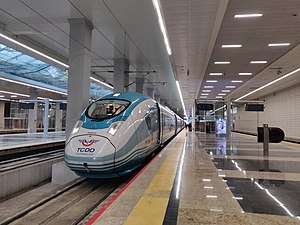 YHT high-speed rail service is the railway's premier train service. Here, HT80004 waits to depart the ATG Terminal in Ankara, bound for Konya. | |
| Overview | |
|---|---|
| Headquarters | Ankara, Turkey |
| Reporting mark | TCDD |
| Locale | Turkey |
| Dates of operation | 1929–present |
| Predecessor | State Railways and Seaports Administration |
| Successor | TCDD Taşımacılık (Railway operations only) |
| Technical | |
| Track gauge | 1,435 mm (4 ft 8 1⁄2 in) standard gauge |
| Previous gauge | 1,520 mm (4 ft 11 27⁄32 in) Broad gauge (Sarıkamış-Gyumri) 750 mm (2 ft 5 1⁄2 in) Narrow gauge (Sarıkamış-Erzurum) |
| Electrification | 25 kV, 50 Hz AC Overhead line |
| Length | 12,532 kilometres (7,787 mi)[1] |
| Other | |
| Website | www.tcdd.gov.tr |
The Turkish State Railways own and maintain all public railways in Turkey. This includes railway stations, ports, bridges and tunnels, yards and maintenance facilities. In 2016, TCDD controlled an active network of 12,532 km (7,787 mi) of railways, making it the 22nd-largest railway system in the world. Apart from railway infrastructure, TCDD also owns several rail transport companies within Turkey as well as a 50% share of the İzmir-area commuter rail system, İZBAN.
Prior to 2017, TCDD also operated all railways in Turkey. However, with the government taking steps to privatise some of the Turkish railway network, TCDD Taşımacılık was formed on 14 June 2016 to take over all railway operations. Handover of rolling stock was signed on 28 December of the same year and TCDD formally ceased all railway operations on 31 December 2016.[3]
History
After World War I and the Turkish Independence War, the Republic of Turkey was a new-formed country. Even though Turkey had a railway network, most of it was operated by foreign companies. The State Railways of the Republic of Turkey (TCDD) was formed on 31 May 1927. TCDD took over the Chemin de fer d'Anatolie-Baghdad, a holding company formed in 1924 by Turkey to take over some rail lines in Turkey, on 1 June 1927 and had control over the tracks of the former Anatolian Railway (CFOA) and the Transcaucasus Railway line in Turkish borders. TCDD now had rail lines to the cities İstanbul, İzmit, Ankara, Afyon, Adapazarı and Konya. On 1 January 1929, TCDD took over the rail line from Mersin to Adana (formerly the Mersin-Tarsus-Adana Railway). Apart from taking over already built lines, TCDD needed to build more line because many important cities were still not serviced by rail. In 1926, TCDD started to build a rail line east to Sivas, reaching Kayseri in 1927 and Sivas in 1930. TCDD continued to acquire from the other rail companies; taking over the Mudanya-Bursa Railway in 1931, the Smyrna Cassaba Railway in 1934, the Ottoman Railway Company in 1935 and the Oriental Railway in 1937. With most of the railways in Turkey under TCDD control, TCDD connected lines such as Kütahya with Balıkesir in 1932 and the former SCP line in Afyon with the former CFOA line. In 1932 TCDD completed the railway to Samsun heading north at Sivas. TCDD continued to build lines, reaching Zonguldak, Erzurum, Erzincan, Diyarbakır and Elazığ in the following years. World War II broke out in 1938, slowing down the building. Between 1938 and 1996 TCDD building decreased. The railway only extended to Gaziantep (1955) and Van (1962).
Formerly planned railways
In 1948 the State Railways released a plan of railway lines that were to be constructed to "ensure national progression and safety".[4] The plan included 5,538 km (3,441 mi) of new railway lines that only 96 km (60 mi) were actually completed; the Gaziantep-Karkamış section of the Narlı-Nusaybin railway was completed in 1960.
Operations
| Government-owned (100%) | |
| Industry | Railway company |
| Predecessor | Société du Chemin de fer Ottoman d'Anatolie |
| Founded | Ankara (1927) |
| Founder | Turkey |
| Headquarters | Ankara, Turkey |
Key people | İsa Apaydın |
| Revenue | |
| Owner | Republic of Turkey |
Number of employees | |
| Website | TCDD Official Website – Homepage (English/Turkish) |
The Turkish State Railways operate most trains in the country. Intercity, regional, suburban, freight and most industrial lines are owned and operated by the State Railways. The only other railways in Turkey include İZBAN (TCDD holds 50% of the company's shares) which operates commuter rail service around İzmir and a few other industrial railways. In addition to rail services, TCDD has been responsible since 1927 for operating several major ports which handle 30% of Turkish port activities.[7]
Passenger operations
The Turkish State Railways operate passenger services on 90% of their system. These are intercity, regional, commuter and international services. In the railways first year 52% of passenger travel in Turkey was by rail, despite the system lacking connections to many parts of the country. Rail transport was the main mode of transport for passengers in the following two decades, reaching an all-time high of 57% of passenger transport in 1947, but then started to decline after 1950, due to the mass construction of roads.[8] Today, the passenger ratio is slowly increasing with the opening of high-speed rail lines in Turkey.
In 2019, almost 150 million people traveled by train in Turkey. 17.5 million on main lines, 8.3 million on high speed lines (2% increase compared to 2018) and 124 million used the Marmaray commuter railway[9]. The share of railway in domestic travels in 2013 is about 2.2%.[10]
The types of passenger service are:
- High-speed (Hızlı Tren): High-speed rail services and TCDD's premier service.
- Mainline (Anahat): Intercity trains operating between major cities.
- International (Uluslararası): Trains operating on international routes, toward Europe or the Middle East.
- Regional (Bölgesel): Trains operating within their respective districts.
- Commuter (Banliyö): Commuter trains, currently operating in Ankara and İstanbul.
High-speed services
High-speed rail in Turkey began service in 2009. TCDD has branded its high-speed service as Yüksek Hızlı Tren or YHT. YHT currently operates on two lines: the Ankara–Istanbul high-speed railway and the Ankara–Konya high-speed railway. They had previously tried accelerated train, i.e. higher speed rail without the necessary upgrades on the railroad tracks.
On 13 March 2009, the first phase of the Ankara–Istanbul high-speed railway entered service between Ankara and Eskişehir. On 25 July 2014, the Ankara-Istanbul high-speed line services began to reach the Pendik railway station on the Asian side of Istanbul,[11] and on 13 March 2019 the services began to reach the Halkalı railway station on the European side of Istanbul, passing through the Marmaray railway tunnel under the Bosphorus strait. There were initially 6 daily departures in both directions.[12] The high-speed line between Ankara and Istanbul has reduced the overland travel time to 3 and a half hours, compared to 5 hours by car.
On 23 August 2011, the YHT service on the Ankara–Konya high-speed railway was inaugurated.
High-speed rail in Turkey is still developing, with new lines currently under construction or in the planning phase. By 2023, the Ministry of Transport and Infrastructure expects Turkey's high-speed rail system to increase to 10,000 kilometers.[13]
Mainline services
Mainline service (Turkish: Anahat) is the railway's main service. In 2010 mainline services made up for 24% of the railways passenger traffic.[14] Mainline service includes 3 types of trains: Express, Blue Train and Passenger.
Express service is between major cities and are fast, comfortable and equipped with modern air conditioned TVS2000 railcars and only stop at important stations. Express trains have an average operating speed of 100 km/h (62 mph) to 120 km/h (75 mph). The most express service is between İstanbul and Eskişehir with 8 trains daily in each direction. Express service also has overnight trains between major cities far apart (e.g. İstanbul-Kars). These trains have coaches, a dining car and a sleeping car or a couchette car or sometimes both.
The TVS2000 railcars used on mainline service are the most comfortable cars in TCDD's entire fleet. TVS2000 railcars may also be used on International service because international services are considered mainline services within Turkey.
International services
International services to Europe
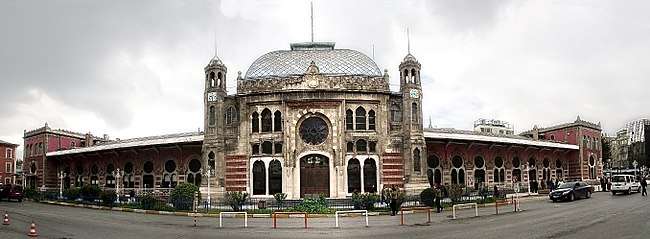
International services to Asia

The Haydarpaşa Terminal is the terminus for a weekly train to Tehran in Iran, another train to Iran travels between Van, Turkey and Tebriz in Iran.[15]
Additionally, trains from Iran to Syria (and vice versa) pass through Turkey.[15]
Former international services
- Tehran – Damascus train Route: Tehran, Tabriz, Razi, Kapıköy, border crossing to Turkey, Van, (train-ferry), Tatvan, Muş, Elazığ, Malatya, Fevzipaşa, Islahiye, Meydanekbez, Turkey – border crossing to Syria, (via Chemins de Fer Syriens) – Meidan Ekbis, Aleppo, Damascus (and back.) This service was interrupted when the border between Syria and Turkey was closed due to the Syrian civil war.[16]
- Taurus Express (Toros Ekspresi), Route: Istanbul: Haydarpaşa Terminal, Eskişehir (Enveriye), Kütahya, Afyon, Konya, Adana, Fevzipaşa, Islahiye, Meydanekbez, border crossing to Syria (via Chemins de Fer Syriens) – Aleppo, Damascus (and back.)[note 1]
- Gaziantep – Baghdad This service was indefinitely suspended since 13 March 2003 with the invasion of Iraq and the ongoing insurgency. Route: Turkey: Gaziantep, Karkamış, Akçakale, Ceylanpınar, Şenyurt, Nusaybin, border crossing to Syria, Al Qamishli, (via Chemins de Fer Syriens), border crossing to Iraq, El-Yaribieh, Rabia, Mosul, Baghdad. It was also running from Istanbul to Gaziantep as mainline until 2003. It is begun again on 16 August 2012 between Eskişehir-Adana[18] but due to renovations, it's shortened to Konya-Adana route on 15 March 2013.[19]
- Dostluk/Fillia Express (IC 90/91), to Thessaloniki, Greece via Uzunköprü, Pythion and Alexandroupolis. It was terminated in February 2011 due to the economic crisis in Greece.
Regional services
Commuter services
As of 2011, the Turkish State Railways operate commuter rail in İstanbul and Ankara, with previous commuter service in İzmir from up to 2006, which is now operated by İZBAN. The railways use the E14000 and the E23000 EMUs on their commuter services. Previously, the newly retired E8000 EMUs and the E4000 electric locomotives were used as well. The first commuter rail service in Turkey was the İstanbul-Halkalı Line on the European side of İstanbul, operating from Sirkeci Terminal to Halkalı in 1955.[20][21][22]
Freight operations
Rail freight transport
From 1980 onwards, rail freight tonne-kilometers transported by the TCDD rose slightly from ≈5000million tonne-km in 1980 to ≈7000million tonne-km in 1990 and to ≈9000million tonne-km in 2000.[23] Approximately 50% of freight moved is minerals or ores, with construction materials increasing to ≈10% in 2000 from less than 5% in 1980, food/agricultural products, chemicals/petroleum, and metal sectors each account for between 5 and 10%. International freight accounted for approximately 5% of totals in 2000.[23]
As of 2012, 25.7 million ton is transported by rail in Turkey. Two steel companies, Erdemir and Kardemir, top 2 customers of TCDD, had transported 4.5 million ton in 2012, mainly iron ore and coal.[24] 2.1 million tons of rail freight belong to international traffic. Most of international traffic is between Turkey and Europe, done via Kapikule. Several container trains are running in this route as well as conventional wagons.[25]
As of 2014, 26.6 million ton is transported on rail in Turkey. 7.1 million of it is done by private wagons. International transport went down to 1.7 million.[26]
Containers are widely used both in international and domestic transportation. 7.6 million ton is carried in containers. TCDD is supporting transportation by containers. Thus almost all of the private railway companies invested in container wagons, and carrying 20% of all rail freight by their own wagons.[27]
TCDD has plans to strengthen freight traffic by adding 4000 km conventional lines until 2023. That includes new international rail connections to Georgia, Iraq and Iran.[28] TCDD is also constructing 18 logistic centers to enable transportation of more loads by rail.[29]
TCDD is planning to increase its transit traffic (11000 to in 2011) by constructing "iron silk road" to connect Europe to Asia. Marmaray is the most important part of this project which was completed in 2015 and now in service.[30] Another project is Kars–Tbilisi–Baku railway which is planned to be completed in 2016 and start functioning in 2017.[31] Also, plans for another supplying project to Kars-Tbilisi-Baku railway, the Kars-Igdir-Nakhcivan high speed railway has been completed.[32] TCDD wants to have share from the freight traffic between Europe and China through this line.[33]
Ports
The State Railways own and operate seven ports throughout the country and has connections to two more ports. The ports TCDD owns are the Port of Haydarpaşa[34] in Istanbul on the southern mouth of the Bosphorus, the Port of Izmir[35] on the Aegean Sea, the Port of Mersin[36] and the Port of İskenderun[37] on the Mediterranean Sea, the Port of Bandırma[38] on the Sea of Marmara, the Port of Derince[39] on the Gulf of İzmit, and the Port of Samsun on the Black Sea. The railways have connections to the Port of Zonguldak,[40] owned by Türkiye Taşkömürü Kurumu (Turkish Coal Company), the Port of Tekkeköy and the Port of Tekirdağ,[41] owned by AKPORT AŞ. In 2004, the privatization of all ports except Haydarpaşa began.[42]
By 2014 Mersin, Iskenderun, Bandirma, Samsun ports are privatized.[43] Tender for privatization of Derince Port has also completed and waiting for takeover.[44]
The state railways are planning on building rail connections to the Port of Güllük[45] (via Çine) and to the Port of Ereğli, which TCDD serviced until 2004.
The ports TCDD owns are the most important in Turkey. The country's five largest ports are owned by the state railways. The Port of Haydarpaşa will soon be decommissioned, when the Marmaray project is complete.
Performance, market share, assets and financial results
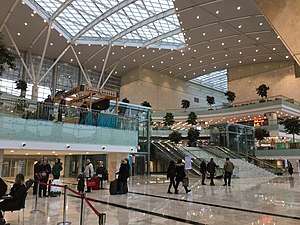
Since 1950, the railway system's market share of freight transportation dropped from 70% to ≈55% (1960), ≈25% (1970), ≈10% (1980, 1990) and to less than 10% in 2000. A similar trend was observed in the percentage of passenger transport performed by rail – dropping from a share of greater than 40% in 1950 to ≈25% in 1960; less than 10% in 1970; ≈5% by 1980; and reaching an all-time low of 2% by 2000.[46] This was partly due to major investment and expansion in the road network.
The TCDD receives subsidies from the government for socially necessary operations, but has registered increasing losses in all its areas of business except for port operations; which have high port tariffs (higher than 36%).[46] By 2000, the cost to the Turkish government had exceeded $500 million per year in addition to a subsidy of over $100 million.[46] In addition to the problems caused by the lack of investment from 1950 onwards, the TCDD organisation has been characterised as suffering from the common problems associated with state-owned enterprises; i.e. emphasis on production rather than customer needs; subject to government reliance and interference; and an inward-looking corporate culture.[46]
As of 2008, the amount of freight transported was the highest ever (18.343 million tonne-kilometers); though actual growth was small over the previous 10 years, and passenger figures had risen slightly overall over the past decade.[42]
As of 2008, the TCDD administers the Ankara Railway Factory, Sivas Concrete Sleeper factory, Afyon Concrete Sleeper factory, Behiçbey rail welding and track machinery repair factory and Çankırı Switch factory. Additionally, the state owned companies TÜLOMSAŞ, TÜDEMSAŞ and TÜVASAŞ are affiliates. The TCDD has a 50% share in the İzmir Banliyö Taşımacılığı Sistemi A.Ş. (İZBAN A.Ş.) which operates the metro in İzmir, and a 15% share in EUROTEM.[42]
Rolling stock
Locomotives
| Model | Picture | Numbers | Built | Number built | Type | Power | Builder (Designer) | Notes |
|---|---|---|---|---|---|---|---|---|
| Road power | ||||||||
| DE24000 | 24001-24418 | 1970–84 | 418[47] | Diesel Electric | 2360 hp (1760 kW) | TÜLOMSAŞ (MTE) | Ordered for TCDD's complete dieselization of its fleet | |
| DE18100 | 18101-18120 | 1978 | 20[48] | Diesel Electric | 1800 hp (1320 kW) | Matériel de Traction Electrique (MTE) | Ordered for use in District 3 | |
| DE22000 | 22001-22086 | 1985–89 | 86[49] | Diesel Electric | 2200 hp (1620 kW) | TÜLOMSAŞ (Electro-Motive Division) | ||
| E43000 | 43001-43045 | 1987 | 45 | Electric | 4260 hp (3180 kW) | TÜLOMSAŞ (Toshiba) | ||
| DE33000 | 33001-33089 | 2003–04 | 89[50] | Diesel Electric | 3300 hp (2463 kW) | TÜLOMSAŞ (Electro-Motive Diesel) | Based on the DE22000 | |
| E68000 | 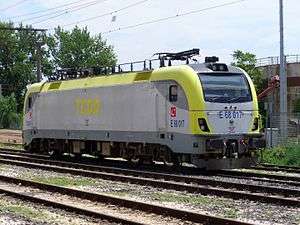 | 68001-68080 | 2013– | 80 | Electric | 6800 hp (5000 kW) | Hyundai Rotem, TÜLOMSAŞ | First 8 built by Hyundai Rotem, later 72 are being built by TÜLOMSAŞ |
| DE36000 | 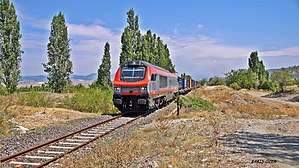 | 36001-36020 | 2013– | 20[51] | Diesel Electric | 3600 hp (2680 kW) | TÜLOMSAŞ (General Electric) | GE PowerHaul type |
| Switchers | ||||||||
| DE11000 | 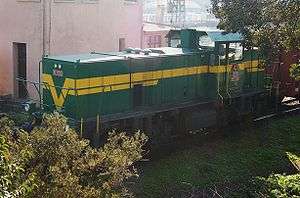 | 11001-11085 | 1985 | 85[52] | Diesel Electric | 1065 hp (780 kW) | Krauss-Maffei, TÜLOMSAŞ | First 20 built by Krauss-Maffei later 60 built by TÜLOMSAŞ |
| DH7000 | 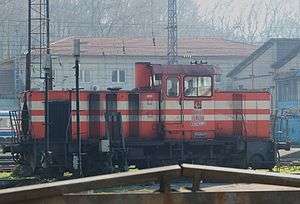 | 7001–7020 | 1994 | 20[53] | Diesel Hydraulic | 710 hp (522 kW) | TÜLOMSAŞ | |
| DH9500 |  | 9501–9526 | 1999 | 26[54] | Diesel Hydraulic | 950 hp (700 kW) | TÜLOMSAŞ | Diesel-hydraulic redesign of TCDD DE11000 to work around short of spare parts for the traction motors of TCDD DE11000 |
| E1000 |  | 1000 | 2015– | 1 | Electric | 1360 hp (1000 kW) | TÜBİTAK MAM, TÜLOMSAŞ | Prototype, mainly used for shunting operations (electric-only adaptation of TCDD DE11000) |
Trainsets
| Model | Picture | Numbers | Built | Number Built | Type | Power | Builder (Designer) | Notes |
|---|---|---|---|---|---|---|---|---|
| MT15000 | 15001-15012 | 2008 | 12 | DMU | 650 kW | Hyundai Rotem | Used for regional services | |
| HT65000 | 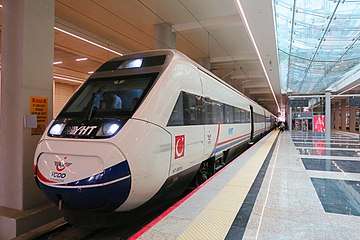 | 65001-65012 | 2007-10 | 12 | EMU | 4800 kW | CAF | TCDD high-speed train sets |
| E23000 | 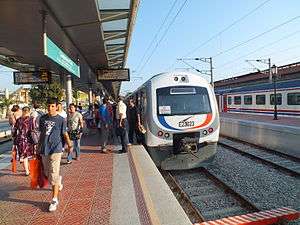 | 23001-23033 | 2009–???? | 33 | EMU | EUROTEM | Başkentray commuter rail | |
| MT30000 |  | 15401-15452 | 2011– | 14 | DMU | 650 kW | TÜVASAŞ | Used for regional services |
| E32000 | 32001-32054 | 2011–???? | 88 | EMU | EUROTEM | Marmaray commuter rail | ||
| HT80000 | 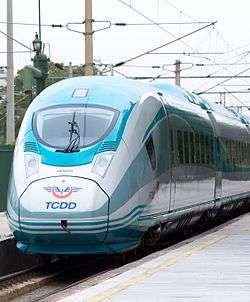 | 80001 & 80101-80106 | 2013–2016 | 16 | EMU | 8000 kW | Siemens | TCDD high-speed train sets |
Railcars
| Model | Picture | Numbers | Built | Number Built | Type | Power | Builder (Designer) | Notes |
|---|---|---|---|---|---|---|---|---|
| MT5700 | 5701-5730 | 1993 | 30 | Railcar | Fiat | Used for regional services |
Passenger cars
| Model | Picture | Built | Type | Builder (Designer) |
|---|---|---|---|---|
| Regional Fleet | 1972 | Coach | TÜVASAŞ | |
| Pullman Fleet | 1980–90 | Coach, Couchette, Diner, Generator | TÜVASAŞ | |
| TVS2000 | 1992 | Coach, Diner, Couchette, Sleeper, Generator | TÜVASAŞ |
Retired fleet
Locomotives
| Model | Picture | Numbers | Built | Acquired | Type | Power | Builder (Designer) | Notes |
|---|---|---|---|---|---|---|---|---|
| Road power | ||||||||
| E4000 | 4001–4003 | 1955 | 1955 | Electric | 2170 hp (1620 kW) | Alsthom | Ordered for use on TCDD's first electrified line. | |
| DE20000 |  | 20001-20005 | 1957–58 | 1957–58 | Diesel Electric | 1800 hp (1320 kW) | General Electric | |
| E2000 |  | 2000 | 1955 | 1961 | Electric | 2346 hp (1750 kW) | MTE | Ex-SNCF BBB 20003 |
| DH27000 |  | 27001-27003 | 1961 | 1961 | Diesel Hydraulic | ???? | Krauss-Maffei | |
| DE21500 |  | 21501-21540 | 1964–65 | 1965 | Diesel Electric | 1580 hp (2150 kW) | General Electric | |
| E40000 |  | 40001-40015 | 1969 | 1971–1973 | Electric | ???? hp (2945 kW) | Alsthom and TÜVASAŞ (Groupement 50 Hz) | |
| E52500 | 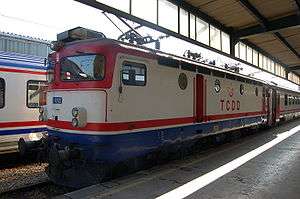 | 52501-52520 | 1967 | 1998–2005 | Electric | 5180 hp (3860 kW) | Končar (ASEA) | Originally built in 1967 as class 441, acquired and overhauled by TCDD in 1998. Returned after loan contract end. |
| Switchers | ||||||||
| DH33100 | 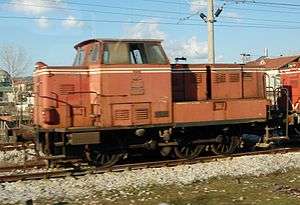 | 33101-33105 | 1953 | 1953 | Diesel Hydraulic | 350 hp (260 kW) | MaK | TCDD's first diesel locomotive. |
| DH44100 |  | 44101-44106 | 1955 | 1955 | Diesel Hydraulic | 800 hp (590 kW) | MaK | |
| DH6000 | 6001 | 1959 | 1959 | Diesel Hydraulic | 610 hp (445 kW) | Jenbacher | Type DH600C | |
| DH4100 | 4101 | 1960 | 1960 | Diesel Hydraulic | 410 hp (300 kW) | Jenbacher | Type DH400C | |
| DH6500 |  | 6501–6540 | 1960 | 1960 | Diesel Hydraulic | 650 hp (480 kW) | Krupp | |
| DH3600 |  | 3601–3624 | 1968 | 1968 | Diesel Hydraulic | 350 hp (260 kW) | MaK | Based on the DE22000. |
| DH11500 |  | 11501-11511 | 1960 | 1982 | Diesel Hydraulic | 1100 hp (810 kW) | MaK | Acquired from Deutsche Bahn in 1982. |
Trainsets
| Model | Picture | Numbers | Built | Type | Power | Builder (Designer) | Notes |
|---|---|---|---|---|---|---|---|
| MT5200 |  | 5201–5202 | 1944 | DMU | 840 hp | MAN | |
| MT5300 |  | 5301–5516 | 1951 | DMU | 1100 hp | MAN | |
| E8000 | 8001–8030 | 1955 | EMU | 1020 kW | Alsthom | ||
| MT5500 | 5501–5511 | 1968 | DMU | 580 hp | Fiat | ||
| E14000 | 14001-14075 | 1979 | EMU | 1040 kW | TÜVASAŞ (Groupement 50 Hz) |
Railcars
| Model | Picture | Numbers | Built | Type | Power | Builder (Designer) | Notes |
|---|---|---|---|---|---|---|---|
| 1-6 |  | 5401–5420 | 1934 | Railcar | 85 hp | Škoda | |
| 21-25 |  | 5401–5420 | 1935 | Railcar | 130 hp | MAN | |
| MV5100 |  | 5401–5420 | 1942 | Railcar | 210 hp | Uerdingen | |
| MT5400 |  | 5401–5420 | 1954 | Railcar | 300 hp | MAN | |
| RM3000 |  | 5401–5420 | 1960 | Railcar | 340 hp | SCF Verney | |
| MT5600 | 1990 | Railcar | 550 hp | TÜVASAŞ | Used for regional services |
Network

TCDD directly owns and operates 8,697 km (5,404 mi) of common carrier lines, of which 1,920 km (1,190 mi) are electrified, throughout 57 provinces.[55] Along with this, the railways own and operate over 240 km (150 mi) of industrial lines and 206 km (128 mi) of high-speed lines, with 574 km (357 mi) of lines under construction.[56] As of 2010, the railways consist of 763 tunnels, 25,441 bridges, 17 wyes and 7 loops.[57] The railway's fleet consists of 467 main line Diesel locomotives, 67 Electric locomotives, 860 passenger coaches, 135 MUs, 33 High-speed rail sets and 15,384 freight cars.[58] TCDD also owns 3 rail ferries.
Standards
- Rail Gauge – 1435 mm (4 ft 8 1⁄2 in)
- Electrification – 25 kV, 50 Hz AC Overhead lines
- Loading gauge – UIC GC
- Traffic – Right-Hand traffic
- Pantograph – 1950 mm (Old) and 1600 mm (New, Rebuilt and High-speed lines)
- Rail – UIC S49 (Old) and UIC 60 (New, Rebuilt and High-speed lines)
- Sleepers – Wooden and Steel (Old) and Concrete (New, Rebuilt and High-speed lines)
- Fastening – Baseplate based with Screw spikes (Old) and Tension Clamp (New, Rebuilt and High-speed lines)
- Platform height – 380 mm (Low platforms), 550 mm (High-speed trains' platforms) and 1050 mm (Commuter rail platforms)
- Coupling – Buffers and Chains (Locomotives and Passenger cars) and Scharfenberg (MUs)
- Brake – Air
- Curve minimum – 200 m (656 ft) and 3,500 m (11,483 ft) (High-speed lines)
Electrification
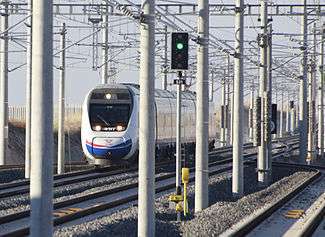
Turkey has chosen to electrify at the conventional 25 kV 50 Hz AC. The first electrified lines were the Istanbul suburban lines on the European side, from Sirkeci to Soğuksu, on 4 December 1955, and in the same period the E8000 electrical multiple units were taken into use. The suburban lines on the Asian side of Istanbul, from Haydarpaşa to Gebze, were electrified in 1969; while the Ankara suburban trains were electrified in 1972, on the line from Sincan to Kayaş.
On 6 February 1977 the tracks from Gebze to Adapazarı were made double track and electrified, allowing the first main line operation of electric trains in Turkey. The line from Arifiye outside Adapazarı to Eskişehir were further electrified in 1989 and in 1993 to Sincan, allowing electric train passages from Istanbul to Ankara. In 1994 the European lines from Istanbul to Edirne, Kapıkule and the Bulgarian border were also electrified. The same year the line from Divriği to İskenderun in eastern Turkey was also electrified, though this line is not connected to the rest of the electrified network. In 2006 the İzmir suburban system was also electrified.
Railway links with adjacent countries
West neighboring countries


East neighboring countries






Logistic centers
TCDD is constructing 18 logistic centers to be completed till 2023 to increase the portion of railway in freight transportation.[29] These centers (also called as freight villages) will have railway connected container yards, cranes, warehouses, customs service and other facilities. These 18 logistic centers are: Halkali, Samsun-Gelemen, Usak (completed) Kosekoy-Izmit, Hasanbey-Eskisehir, Kaklik-Denizli, Bogazkopru-Kayseri (partially completed) Yesilbayır-Istanbul, Gökköy-Balikesir, Bozüyük-Bilecik, Kayacık-Konya, Yenice-Mersin, Sivas, Türkoğlu-Kahramanmaraş, Kars, Palandöken-Erzurum, Mardin (under construction)
Yards and depots
TCDD owns and operates many facilities throughout Turkey. These facilities are; yards for storing freight and passenger cars, depots and locomotive shops for repair and maintenance and freight facilities for transferring or storing freight.
Güvercinlik Yard in central Ankara is the largest railway facility in Turkey. This multi-use facility includes a marshaling yard, passenger yard, 3 repair shops, for passenger cars, freight cars and locomotives, freight transfer terminal and a grain silo siding. The Haydarpaşa Yard is the second largest yard in Turkey, consisting of a freight yard, passenger yard, 3 maintenance shops for locomotives, passenger cars and freight cars, and a loop for trains.
- Güvercinlik Yard in Ankara is the largest rail yard in Turkey.
- Haydarpaşa Yard in İstanbul is the largest passenger yard in Turkey.
- Etimesgut Yard in Ankara is the largest high-speed rail yard in Turkey (under construction).
- Ispartakule Yard in İstanbul is a high-speed rail yard in Turkey (under planning).
- Tüpraş loading facility is the largest freight yard in Turkey.
- Halkalı logistics center is the largest multipurpose freight yard in Turkey (under re-construction).
- Güvercinlik Maintenance Facility is the largest electrified maintenance facility in Turkey.
- Halkapınar Maintenance Facility is the largest non-electrified maintenance facility in Turkey.
- Eskişehir Railway Shops are the largest railway construction facility in Turkey.
Ferries

The Turkish State Railways own and operate two rail train ferries and connects to three others.
The most famous of these would be the Bosphorus train ferry in İstanbul. This ferry connects Haydarpaşa, on the Asian side, with Sirkeci, on the European side. Demiryolu and Demiryolu II are the two ferries that operate on the route and are owned by TCDD.
By starting the project of Marmaray, TCDD ended the Bosphorus train ferry and announced an alternative ferry for the freight trains passing from Europe to Asia or vice versa: Tekirdağ-Derince Ferry. It's a private ferry named Erdemir working as a subcontractor of TCDD. Ferry did trials in 2012, and had started regular transportation at the end of 2013.[60] Ferry has 5 lines with 800-meter total length.
The other train ferry owned by TCDD would be the Lake Van ferry, connecting Tatvan and Van via Lake Van, Turkey's largest lake. This ferry is a part of the only railway connection between Turkey and Iran, and thereby between Europe and India. Van is the name of the ferry that operates on the route and is also fully owned by TCDD.[61]
Other train ferries:
Network extensions and modernizations
The Turkish State Railways currently has many network extension and modernization projects planned. TCDD is seeing the largest investment since the 1930s and with these investments is constructing new lines, primarily high-speed lines.
In addition to 5000 km high-speed line, Turkish Ministry of Transportation announced the construction of 4000 km new conventional rail lines as a part of 2023 strategy.[28]
TCDD has also been renewing the existing lines, some to be electrified, signalized and/or made double tracked. The budget for renewals and infrastructure of existing lines is more than 1 billion TL in 2014.[63]
There are also commuter rail projects (renewal or new lines) like Marmaray, Egeray, Başkentray or Gaziray that are complete, under construction or planning phase.
See also
- Rail transport in Turkey
- Ankara Suburban Railway
- Haydarpaşa Terminal
- High-speed rail in Turkey
- Istanbul-Damascus-Medina Railway
- Istanbul-Konya-Baghdad Railway
- Kars-Tiblisi-Baku railway
- List of railway stations in Turkey
- List of TCDD routes
- List of train accidents in Turkey
- Orient Express
- Sirkeci Terminal
References and notes
Notes
- Discontinued as of 2009[17]
References
- Invest in Turkey: Transportation and logistics
- TCDD History – Trains and Railways of Turkey
- "Hakkında". tcddtasimacilik.gov.tr (in Turkish). Retrieved 29 November 2017.
- Tanıl Bora (2012). Tren Bir Hayattır. Istanbul: Iletişim yayınları. p. 114. ISBN 978-975-05-1064-9.
- Annual Statistics of the Turkish State Railways, T.C.D.D., available at http://www.tcdd.gov.tr/files/istatistik/20102014yillik.pdf
- Annual Sector Report of the Turkish State Railways, T.C.D.D., available at http://www.tcdd.gov.tr/files/istatistik/2014sektorrapor.pdf
- Land transport/Rail – Republic of Turkey 2006 www.abgs.gov.tr
- TCDD ratios 1922–2005
- Anadolu Agency. "Turkish railways posts record figures for 2019", 12 June 2020
- Uysal, Onur. "Turkish Railway Industry Report 2013 – Passenger", Rail Turkey, 24 July 2014
- Uysal, Onur. "First High Speed Train Set on Ankara Istanbul Line Arrived Istanbul", Rail Turkey, 26 July 2014
- Uysal, Onur. "New Schedule for Istanbul-Ankara High Speed Train", Rail Turkey, 9 August 2014
- Turkey's high-speed rail system will be complete by 2023 – rayturk.net
- 2010 TCDD Statistics – tcdd.gov.tr
- "TCDD: Destinations in the Middle East". tcdd.gov.tr. Retrieved 2 April 2018.
- "Turkey Closes Syria Border Crossings". The Wall Street Journal. 25 July 2012. Retrieved 2 April 2016.
- Brosnahan, Tom. "Toros Ekspresi Adana – Konya". Turkey Travel Planner.
- "Vagonları yenilenen "Toros Ekspresi" 16 Ağustos'da seferlerine başlıyor". www.rayhaber.com. Retrieved 2 April 2016.
- "Toros Ekspresi seferleri iptal edildi". www.rayhaber.com. Retrieved 2 April 2016.
- İstanbul Ulaşım: Istanbul Metropolitan Municipality Transportation Services
- "EGO Genel Müdürlüğü: Ankara Metropolitan Municipality Transportation Services". ego.gov.tr. Retrieved 2 April 2018.
- "İzmir Metropolitan Municipality: İzmir Metro". izmir.bel.tr. Retrieved 2 April 2018.
- Restructuring options for reform of TCDD, World Bank report 2003, hwtsk.com
- Uysal, Onur. "Leading Railway Clients 2012", Rail Turkey, 16 December 2013
- Uysal, Onur. "Leading Railway Companies In Turkey 2012 – European Traffic", Rail Turkey, 14 June 2014
- Uysal, Onur. "TCDD Annual Statistics 2013", Rail Turkey, 23 October 2014
- Uysal, Onur. "Leading Railway Companies In Turkey 2012 – Railcar Owners", Rail Turkey, 15 July 2013
- Uysal, Onur. "2023 Targets in Rail Freight – Network", Rail Turkey, 11 July 2013
- Uysal, Onur. "2023 Targets in Rail Freight – Logistic Centers", Rail Turkey, 5 December 2013
- Uysal, Onur. "When Asia and Europe Will Be Connected?", Rail Turkey, 10 December 2013
- Uysal, Onur. "10 Things to Know About Baku-Tbilisi-Kars Railway Project", Rail Turkey, 20 October 2014
- Kars-Iğdır-Nahçivan Hızlı Tren Projesi (KIN)
- Uysal, Onur. "Is Marmaray Key for Europe-Asia Rail Connection?", Rail Turkey, 12 November 2013
- Port of Haydapaşa, tcdd.gov.tr
- Port of İzmir, tcdd.gov.tr
- Port of Mersin, tcdd.gov.tr
- Port of İskenderun, tcdd.gov.tr
- Port of Bandırma, tcdd.gov.tr
- Port of Derince, tcdd.gov.tr
- Port of Zongulak, Port statistics
- AKPORT transport, akport.com.tr
- TCDD annual report 2008 www.tcdd.gov.tr
- Uysal, Onur. "Railway Connected Ports of Turkey", Rail Turkey, 12 February 2014
- Uysal, Onur. "Safi Kati Yakit is the New Operator of Derince Port", Rail Turkey, 9 June 2014
- AYDIN-ÇİNE-YATAĞAN-GÜLLÜK RAIL PROJECT – dlh.gov.tr
- TCDD Challenges Author: Lou Thompson, 3 May 2002 www.tgassoc.com
- "DE24000". trainsofturkey.com. Retrieved 30 April 2018.
- "DE18100". trainsofturkey.com. Retrieved 30 April 2018.
- "DE22000". trainsofturkey.com. Retrieved 30 April 2018.
- "DE33000". trainsofturkey.com. Retrieved 30 April 2018.
- "DE36000". trainsofturkey.com. Retrieved 30 April 2018.
- "DE11000". trainsofturkey.com. Retrieved 30 April 2018.
- "DH7000". trainsofturkey.com. Retrieved 30 April 2018.
- "DH9500". trainsofturkey.com. Retrieved 30 April 2018.
- TCDD Statistics – Trains of Turkey
- Hızlı Tren Hakkında Herşey (A Complete Reference to Turkish High Speed Rail) – by T.C. Devlet Demiryolları İşletmesi Genel Müdürlüğü
- 2010 TCDD Annual Report – www.tcdd.gov.tr
- 2007 TCDD Annual Report – www.tcdd.gov.tr
- Railway Gazette International – January 2008 p51
- Uysal, Onur. "Wagons On Board: Tekirdag Derince Ferry Departed", Rail Turkey, 11 November 2013
- Turkey's Train Ferries – Trains and Railways of Turkey
- http://www.upmtrans.com/english/ferry.html
- Uysal, Onur. "Railway Investments of Turkey in 2014", Rail Turkey, 21 January 2014
External links
| Wikimedia Commons has media related to Turkish State Railways. |
- Turkish Railways Company Website
- Turkish Railway Company (TÜVASAŞ) Website
- A Short History of Turkish Railways including maps
- Turkish Railways Company Workers and Retired Personnel Social Aid Foundation
- Republic of Turkey Ministry of Culture – Ankara Railway Museum
- Republic of Turkey Ministry of Transport
